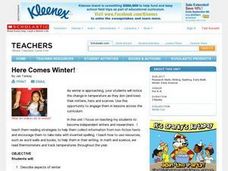Curated OER
Here Comes Winter!
Students investigate winter behaviors in animals. They describe winter and write about the characteristics of the season by drawing and labeling a winter picture. Students then conduct research on a chosen animal and create a chart. ...
Curated OER
What is Wrong with My Pet? - An Introduction to Zoonoses
Young scholars describe how ringworm and roundworm cause diseases in both humans and animals. In this life science lesson, students research how these diseases can be transmitted. They create an information brochure to promote public...
Curated OER
Teach Inventions with PowerPoint
Students research famous inventors and what they invented. In this technology lesson, students gather facts about a specific invention and create a PowerPoint slideshow about it. Students practice adding in animation and color to the...
Curated OER
Creature Seekers
Does it actually exist? Consider the sighting of a giant squid, much like the one that appears in 20,000 Leagues Under the Sea. Middle and high schoolers read the article One Legend Found, Many Still to Go, and research other mysterious...
Curated OER
The Legendary Raptors
How are raptors and airplanes alike? Combine science and language arts in this fun and interactive project. Young scientists research the animal in order to design their own aircraft, and compete in a contest for farthest, fastest, and...
Curated OER
WWW = World Wide Wildlife
Through video, internet research, and hands-on activities, learners conduct a study of the interdependence between animals and the habitats they live in. They conduct Internet research independently in order to complete a report on a...
Curated OER
Animals of the Arctic
Sixth graders research an Arctic animal. They survey the questions in the Animal Report in order to conduct their research. They investigate their chosen animal by using the Internet, library books and reference books.
Curated OER
Which Animals Should Be Saved?
Fifth graders investigate the concepts related to the endangerment of different animal species. They conduct research using a variety of resources. The skills of prediction are used to show the possible outcome of the extinction of a...
Michigan State University
Friend or Foe?
What one person thinks is a pest may not be a pest to someone else. Here, scholars examine the characteristics of living things and pests through grand conversation and a variety of activities. Class members play a game of pest or not a...
American Museum of Natural History
Drawing Dinos
Five steps walk budding artists through the process of drawing a dinosaur. A drawing guide showcases four dinosaurs—stegosaurus, tyrannosaurus rex, triceratops, and allosaurus.
Curated OER
When is Your Animal Most Active?-- Class Bar Graph
In this science and math worksheet, a group of students participate in graphing what time of day their chosen animals are most active. Students fill out the bar graph choosing day or night.
Curated OER
The Animals Kingdom
Students are introduced to the classification system of animals. In groups, they set up an aquarium in which they must maintain throughout the year. They also observe earthworms and how they react to various stimuli and research the...
Curated OER
What's for Dinner?
View a video presentation comparing chemosynthesis to photosynthesis. Review the findings of the 2004 Ring of Fire Expedition that studied biological communities around the hydrothermal vents of the Mariana Arc. In...
Cornell University
Field Day: Be an IPM Detective
Become a pest detective! Individually or in small groups, scholars scout the land to discover which pests—plant and animal—inhabit it, determine whether the pests are endangering the environment, and summarize their findings.
Curated OER
Our Way of Life
Young scholars interview Native American Elders about animal migration, traditional food gathering, and subsistence. They research endangered animals, draw a game cycle, and create maps of local migration of animals.
Curated OER
Animals at the Zoo
Students identify a variety of animals that can be found at the zoo and select one to conduct research on. In pairs they conduct Internet research, complete a graphic organizer chart, and create a two slide PowerPoint presentation.
Curated OER
Vertebrates are Cool!
Students conduct research on various vertebrates. They read the eBook 'Vertebrates,' select a vertebrate, conduct research, and create an eBook with one photo about their chosen vertebrate.
Curated OER
Endangered Species
Students explore the various reasons for animals becoming endangered and threatened with extinction. Within this instructional activity, students choose an animal to research and then creativity introduce their animal to the rest of the...
Curated OER
An Introduction to Dinosaurs
Students research to collect information about dinosaurs. In this dinosaurs lesson, students brainstorm what they know about dinosaurs and chart the information that are fats. Students take a pretest about the topic and view a PowerPoint...
Curated OER
Stem Cells: 5 Year Progress Report
Students explore different aspects of stem cells. In this human biology lesson, students complete numerous activities including reading an article and discussing it, watching a video on stem cells reproducing over time, and...
Curated OER
Researching an Animal (Class Book)
Third graders research an animal in order to gain knowledge of the adaptations that allow it to survive in the desert. They present this information to the rest of the class in oral reports, and by contributing to the class book.
Curated OER
Presentation of Research with HyperStudio
Learners report information about a Michigan native animal in a Hyperstudio stack. They gain interest from the animals that they chose from instructional activity 1 by using the software.
Curated OER
Jan Brett Encyclopedia Lesson
Third graders develop encyclopedia skills to locate information. In this Jan Brett library lesson, 3rd graders research animals in the encyclopedia and complete a worksheet on one animal. Students relate their work to the work of Jan...
Curated OER
Reading Research!
Students observe the pictures in non-fiction books that focus on animals in the winter. In addition, they also listed to some read aloud books about hibernation, migration, adaptation and dormancy. Students draw pictures and write notes...

























